Love sweet potatoes? Learn how to grow sweet potato vine for an antioxidant punch even more potent than the revered root. (With bonus recipe!)
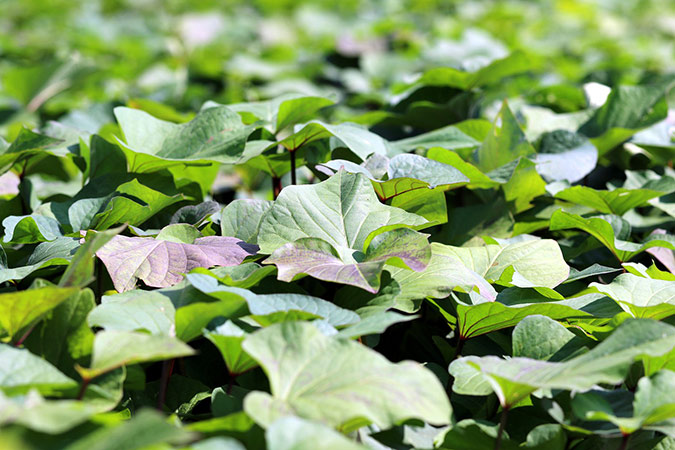
Image by manseok Kim from Pixabay
How to Grow Sweet Potato Vine: Antioxidant Powerhouse
I love sweet potatoes. The roots are one of the most delicious, versatile, high-calorie, easy-to-grow, long-storing veggies around.
Many homesteaders who have a long growing season stockpile sweet potatoes in their garden beds from spring to fall—and then in their cellar from fall to spring. Surprisingly, though, most sweet potato growers don’t realize that the vines are also an incredible food source.
This article on growing sweet potato vines is part of our Green of the Month series. Click here to read the rest of the articles in the series.
If you have a crop of the beloved root in the ground now, keep reading to learn how to grow sweet potato vine so you can start enjoying the greens while you wait for your roots to be ready to harvest and cure.
The Goods on Sweet Potato Vine
The nutritional benefits of sweet potato roots are well known. But if you are like I was just a few years ago, you may not be aware of how fabulously nutritious sweet potato vines are. So let’s get to the goods on sweet potato vines.
#1: Antioxidant Hero With Cancer-Fighting Clout

Image by silviarita from Pixabay
Sweet potato vine is a low-calorie, high-vitamin green that’s packed with folate, potassium, magnesium, and vitamins A and B6. Vitamin content aside, though, there’s an even more important reason to eat your sweet potato greens. According to Shahidul Islam, professor of plant science at the University of Arkansas at Pine Bluff, “Sweet potato leaves contain more total polyphenols than any other commercial vegetables, including sweet potato roots and potato tubers.”1)https://www.uaex.edu/publications/PDF/FSA-6135.pdf
In case you’re not familiar with polyphenols, they are a class of antioxidants known to be particularly effective at helping to prevent cancer. Also, according to Mr. Islam, these potent leaves may have anti-diabetic and antibacterial properties.
#2: Prolific Producer in Hot Weather
During the hottest months of the year, sweet potato vines are one of the most prolific leafy-green producers in my garden. Also, anyone who knows how to grow sweet potato vine knows you can easily use your existing vines to make new plants, even in extreme heat when most leafy greens will not germinate.
#3: Incredible Edible
The antioxidant factor alone is enough to make me want to eat my sweet potato greens. But these vines are actually delicious too!
The young leaves are great chopped and added to salads. The more mature leaves are wonderful stir-fried with garlic and olive oil or butter. The really mature leaves and vines, pulled up when you start to harvest, make a great substitute for spinach in dishes like creamed spinach and palak paneer.
Read to the end for a dreamy Curried Creamed Sweet Potato Greens recipe!
A Few Cautions About Sweet Potato Vines
As a mostly self-sufficient homesteader living in USDA Hardiness Zone 7a, I don’t see many downsides to growing sweet potato vine. However, these vines can be problematic for some growers.
Sweet Potato Plants Are in the Morning Glory Family
Sweet potatoes belong to the morning glory family. As you learn how to grow sweet potato vine, here’s a word to the wise: Morning glory-related plants can be notoriously invasive.
In cold climates, the vines are instantly killed by frost, and the tubers will rot in the ground if left there over the winter. So there are no risks that sweet potatoes will get out of control.
In climates that stay above freezing, though, sweet potato vines can become invasive if left unharvested. The plants also self-propagate, so they can spread to new areas quickly.
You May Also Enjoy:
“The Wonderful Winged Yam: Demonized Invasive or Prolific Staple?”
Also, unless you plant bush-type sweet potatoes (which are much less productive), you should expect your sweet potato vines to overgrow their beds and attempt to move into neighboring areas. Even though you only need to plant them 3 feet apart for root growth, they’ll cover about 6–8 feet of garden bed space.
Sweet Potato Vine Is Picky About Growing Conditions
Despite the fact that sweet potato plants have low nitrogen needs and can even grow in poor soils, they are pretty picky about watering for the first 30–40 days after planting. If they get too much or too little water, the plants will not thrive.
Also, though they grow well in hot weather, they are very intolerant of cold weather. Even a few cool nights close to 40ºF can stress the plants to the point of death. For best results, you don’t even want to put your plants in the ground until the soil reaches at least 60ºF.
How Sweet Potatoes Grow
Before we dig into the details of how to grow sweet potato vine for its savory greens, let’s take a step back and look at the basics of how sweet potato plants are designed to grow in nature.
Relationship Between Vines and Roots
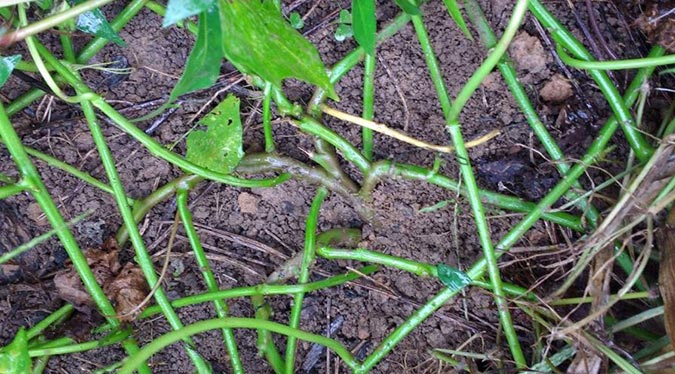
Multiple vines snake out from a single root zone in Medusa-like fashion
Unlike most plants, which need elaborate underground root systems to support healthy leaves and set above-ground fruit, sweet potatoes need elaborate above-ground leaf systems to grow large roots.
In Medusa-like fashion, sweet potato vines snake out from the mother plant—spreading, climbing, and occasionally setting new shallow roots to anchor the vines in place. When leaf growth reaches critical mass, the plant begins to fill underground storage roots with sugars and nutrients drawn from sun and soil.
In prepared garden beds, root storage usually starts at around 30–40 days after planting. Depending on the variety planted and the growing conditions, it can then take up to 6 months for the roots to reach their full potential size.
Rooting Out the Root’s Function
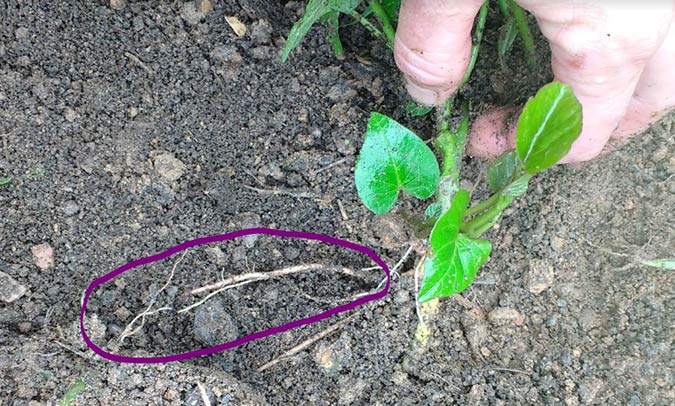
Start of a storage root in a 2-week-old plant
The purpose of this elaborate underground root storage system, from the plant’s perspective, is survival. Those roots are a reserve of food that the plant can draw on during periods of poor growing conditions. For example, in an extended drought, nutrients and moisture can be drawn from the roots to sustain the vines until rain comes.
Also, if animals eat the above-ground leaves and stems, the stored energy in the roots can be used to grow new vines and start the cycle of gathering and storing nutrients all over again.
Starting Sweet Potato Slips
At home, we use those sweet potato roots not only for eating, but also to start new plants. Taking advantage of the roots’ survival mechanisms, we force the root to produce what we call “slips” or sweet potato plant starts.
Slips From the Root
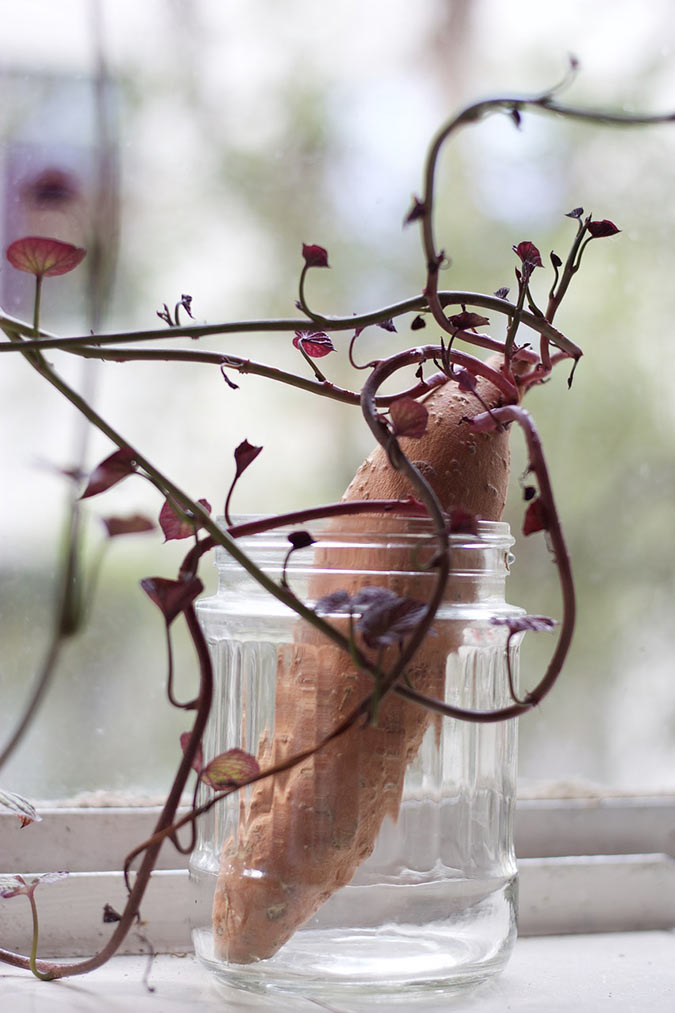
Image by Elle Hughes from Pixabay
To do this, simply put the whole root, or a cutting from the root, in contact with water or moist soil. This wakes the root up from dormancy and encourages it to grow new vines and create more storage roots. As the vines and roots form, you can separate them from the root and treat them like new plants.
Slips From a Mother Vine
Starting new sweet potato vines from the root can sometimes lead to transmission of diseases. Roots can host fungal pathogens that may be transferred to new plants started directly from those roots.
Even if roots are infected, those fungal pathogens generally do not pass through to the vines. So, to minimize the risk of fungal pathogen transmission, you can instead start new plants from mother vines.
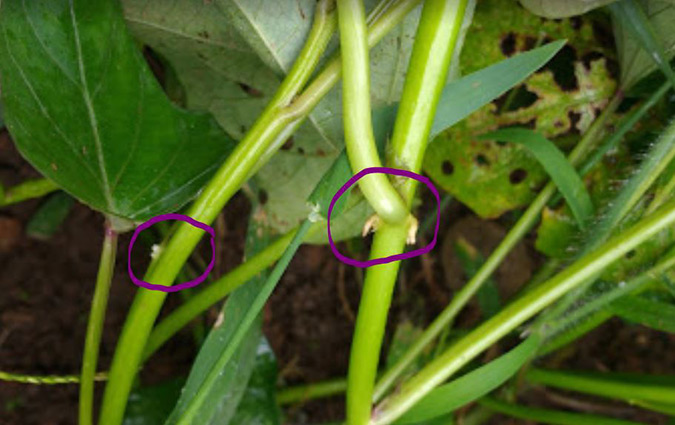
New roots starting to grow on the sweet potato vine stem
In nature, when the plant begins to vine, some of those vine stems make contact with the soil and grow new roots. When the roots get deep enough, they start to create their own storage roots.
Once established, if these new root systems get separated from the mother plant, they become a mother plant and begin making their own new baby plants. This process is called “layering.”
If you want to grow lots of sweet potato greens for eating, layering with sweet potato slips is a great way to create disease-free plants with minimal work.
Tips on How to Grow Sweet Potato Vine … and the Roots!
If you aim to grow sweet potato plants for their roots, you can harvest about 20-30% of your vines for fresh eating. Alternately, you can create new plants specifically for the purpose of growing lots of those antioxidant-rich greens.
Harvesting Leaves From Plants Grown for Roots
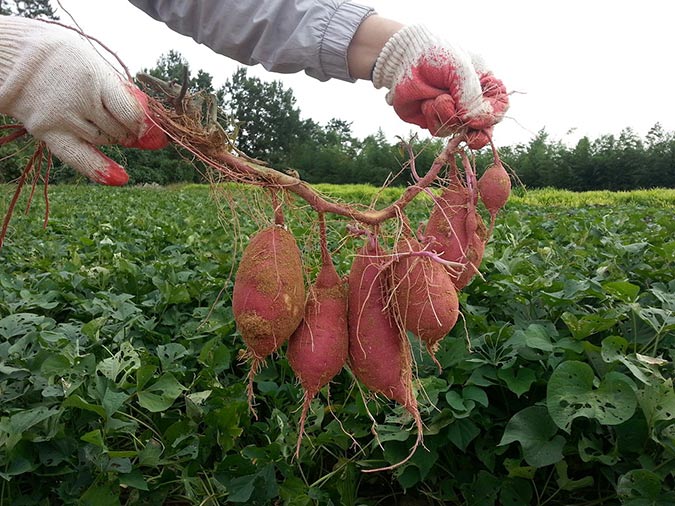
Image by Chang Min SHIN from Pixabay
If sweet potato roots are your goal, overharvesting the vines can lead to a reduction in root size. In theory, you can harvest 20-30% of the leaf mass for fresh eating if your plants are growing vigorously. However, the hard part is figuring out exactly how much that is over the life span of the plant.
Personally, my method is to harvest every fifth leaf on a vine once the vines are abundant (usually around 80 days after planting). I have 6 beds with vines, so I harvest from a different bed each week. That way, I only end up harvesting leaves from a plant once every 6 weeks. So far, this technique has not reduced the root size of my winter-storage sweet potatoes.
Additionally, when it comes time to harvest my sweet potato roots, I use the portions of the vines that are still healthy to make large batches of the curried creamed greens for freezing.
Growing Sweet Potato Plants for Vines Rather Than Roots
I love sweet potato greens so much that I also grow some plants specifically for the greens. That way I can harvest heavily without worrying about reducing root production.
Once your vines are growing, you can easily layer your vines to start new plants as described earlier. Sweet potato vines are so eager to set roots that you can take cuttings from your vines and plant them even when they don’t have roots yet. As long as you keep your cuttings well-watered, they will grow roots quickly.
I like to start a few new plants each week to keep a steady supply. When the vines get about 3 feet long, I harvest everything back to a few inches in length. When they get 3 feet long again, I cut them.
Soil Requirements
Sweet potato plants grow well in a variety of conditions. They can tolerate pH ranges from 4.5 to 7.5, though they tend to grow best with a pH closer to 6.
Any soil texture type with the word “loam” in it, such as clay-loam, silty-loam, or sandy-loam, is suitable for growing sweet potato vines. If you have heavy clay soils, you’ll need to incorporate lots of organic matter prior to planting sweet potatoes in order to get a good harvest.
If you aren’t sure of your soil type, check out this article for details: “Clay, Sand, Silt, or Loam? Discover Your Garden’s Soil Texture In 5 Easy Steps.”

Image by Dean Moriarty from Pixabay
Sweet potatoes are highly susceptible to fungal pathogens if planted in areas prone to holding water. Choosing a location with good drainage is critically important.
Sweet potato plants don’t require much nitrogen or phosphorous, but they have high potassium needs. Amending your soil with compost that included banana peels can help.
Also, if your soil is short on potassium, adding a light dusting of wood ash on your garden bed can help. Make sure you can still see your soil under your wood ash to avoid overdosing your soil. Or for more precision, use bagged kelp meal fertilizer to add potassium.
For best results, perform a soil test to ensure adequate potassium.
You May Also Enjoy:
“At-Home Soil Test Kits: How to Use Them . . . And Why You Should”
“Supercharge Your Garden! 4 Steps to Vibrant Soil Using Compost and Crop Rotation”
“Homemade Natural Fertilizer–15 Simple and Inexpensive Options”
Plant Spacing
Sweet potatoes for vines and roots grow well on 3-foot centers. If you plan to trellis your vines, you can reduce that spacing to plant about every 2 feet apart.
Trellising the vines makes weeding and harvesting greens easier. However, the vines will not be able to layer if grown vertically. If you plan to use an existing vine to make new plants, make sure to let your mother plant grow horizontally and in direct contact with soil.
Plant Care
For the first 30-40 days of growing, ensure that sweet potato plants get at least an inch of water per week. Mulch around the plant base to preserve moisture.
Use dark mulch or black plastic in cooler climates to increase the soil temperature around the roots and expedite growing speed.
Weed weekly until the vines take off. Once vines are a few feet long, the plants can withstand some weed pressure, so aggressive weeding is not required.
Note: You can also grow sweet potato vines in containers in sunny areas of your heated house if you want a year-round supply in cold climates!
Varieties of Sweet Potatoes
There are hundreds of varieties of sweet potatoes. Heirloom seed suppliers like Southern Exposure Seed Exchange offer many different types. And although I have never ordered from them, Sand Hill Preservation Center has one of the most impressive collections of sweet potato varieties I have come across.
My two favorite sweet potato varieties are Beauregard and Georgia Jet. They both grow prolific vines and large tubers. O’Henry is also an excellent choice for disease resistance in areas that may be more susceptible to fungal pathogens.
Generally, for the purposes of growing vines, avoid the bush or bunch varieties.
The Difficulty In Growing From Sweet Potato Vine Seeds
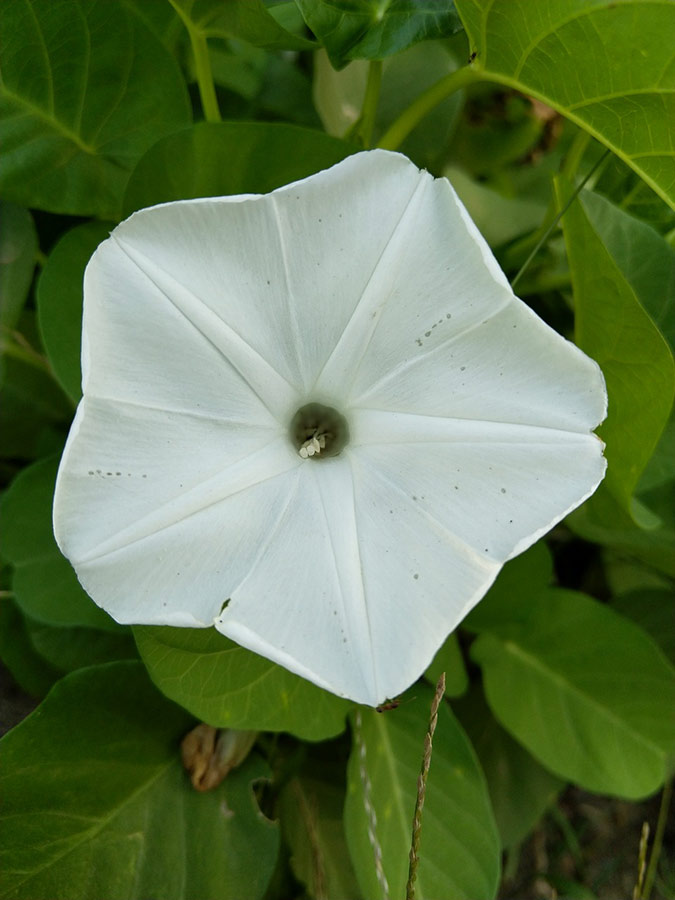
Image by Guangyan Zhang from Pixabay
Sweet potato vines also flower and produce seeds in the right conditions. The plants generally only flower in the mornings, and the flowers only live for a few hours. Regardless, why don’t we typically use these sweet potato vine seeds to grow new plants?
Pollination is performed mainly by bees, who generally don’t get active pollinating until late morning to afternoon. As a result, pollination of the flowers is rare.
Additionally, the plants tend to set flowers only during periods of stress, such as with irregular watering. Therefore, it’s pretty clear that nature didn’t mean for sweet potato plants to reproduce by seed.
You May Also Enjoy:
“How to Grow a Peach Tree From Seed (Hint: Don’t Toss Those Pits!)”
Still, if you want to have an experience few gardeners will ever get, hand-pollinate all your open flowers using a paint brush. Collect the sweet potato vine seeds, and plant them. If you cross-pollinate different varieties, your outcomes may be completely different than your parent plants. Alternately, you can go the easy route and purchase sweet potato seeds.
Unconventional Growing Tips for Adventure Gardeners
Sweet potato plants make great clay breakers. Prepare a few inches of soil to start plants. Then let the sweet potatoes grow until they die.
When they die, leave the roots in the ground to decompose in place. This creates habitat for soil life and helps break up compacted clay soils.
Sweet! Your Bonus Recipe Is Here…
Curried Creamed Sweet Potato Greens
There are several ways to cream leafy greens. My personal preference is to put about a quarter inch of water in the bottom of a large pot and then fill the pot with bunches of leaves and stems.
After that, put the lid on, turn on the burner, and give the greens a few minutes to wilt. Every few minutes, open the lid and stir the greens to keep them from sticking and to move unwilted greens closer to the heat. Repeat until all your greens are well-wilted.
While there’s still some water in the pot with the greens, add your spices. You can toss in your favorite curry spice mix, or make your own.
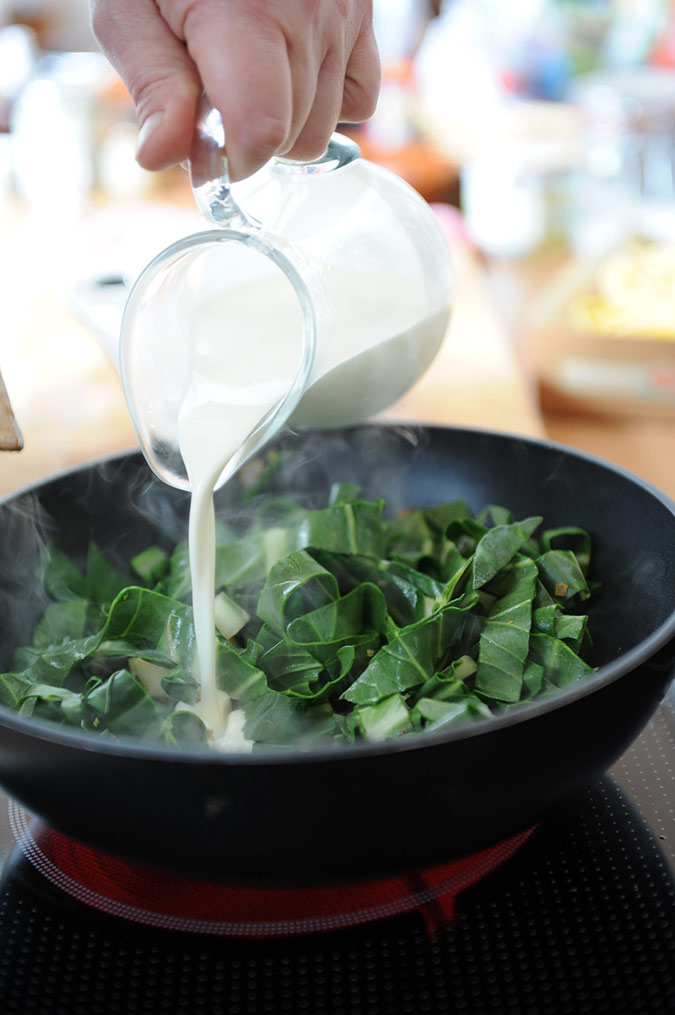
Image by Antina Wolff from Pixabay
For every 4 cups of cooked greens, I use the following spice mix:
- ½ tsp. powdered coriander seeds
- ½ tsp. powdered turmeric root
- ¼ tsp. ground fennel seeds
- ¼ tsp. of some sort of powdered pepper (e.g., cayenne, paprika, gotchu)
- 2 in. fresh ginger, peeled and minced
- 6 large garlic cloves, peeled and minced
- Bit of honey (to counter any bitterness in the greens)
- Salt and pepper to taste
If you want to make your sweet potato greens taste like the spiced spinach in palak paneer, add these optional items too:
- 2 medium sauteed onions
- ¼ tsp. garam masala
- A few methi (fenugreek) leaves if you have them
- Dash of cinnamon
Stir in your seasonings, and allow the extra water in the pan to cook off. When your greens just start to stick, turn off the heat and add one of these options to cream your greens:
- Stick of butter (my favorite)
- ½ c. cream
- ½ c. plain yogurt
- ½ c. of your favorite dairy substitute
Stir your mix. Then use an immersion stick blender to chop your greens in the pot. Or you can transfer your greens to your food processor and pulse until the greens are the consistency of creamed spinach.
Ways to Serve Your Curried Creamed Sweet Potato Greens
You can serve this up as a side dish to your main course. You can spread it over a bed of rice with cashews and call it dinner. This stuff also makes a wonderful savory crepe filling.
In addition, you can blend it into a smooth paste, add bone or vegetable stock, and transform it into a delicious soup.
Read More: “How to Make Bone Broth in 5 Easy Steps + Benefits & Uses”
What Do You Think?
Grow sweet potato plant . . . get sweet potato power! Are sweet potato greens going to be appearing on your dinner table soon? Share your thoughts in the comments below.
—————————-
This is an updated version of an article that was originally published on September 28, 2018. The author may not currently be available to respond to comments; however, we encourage our Community members to chime in to share their experiences and answer questions!
The Grow Network is a participant in the Amazon Services LLC Associates Program, an affiliate program designed to provide a means for our team to earn fees for recommending our favorite products! We may earn a small commission, at no additional cost to you, should you purchase an item after clicking one of our links. Thanks for supporting TGN!

Tasha Greer is a regular contributor to The Grow Network and has cowritten several e-books with Marjory Wildcraft. The author of “Grow Your Own Spices” (December 2020), she also blogs for MorningChores.com and Mother Earth News. For more tips on homesteading and herb and spice gardening, follow Tasha at Simplestead.com.
References
| ↑1 | https://www.uaex.edu/publications/PDF/FSA-6135.pdf |
|---|

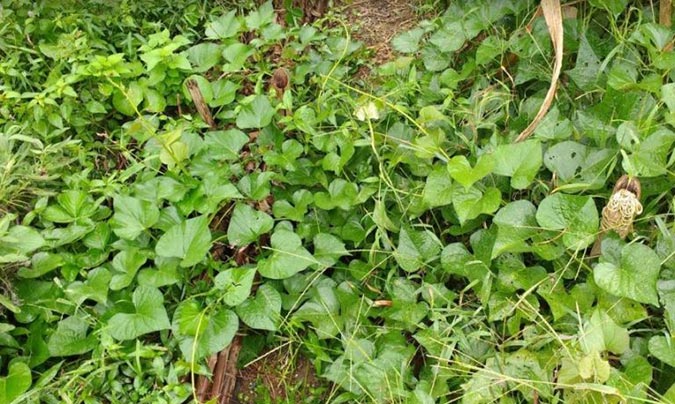
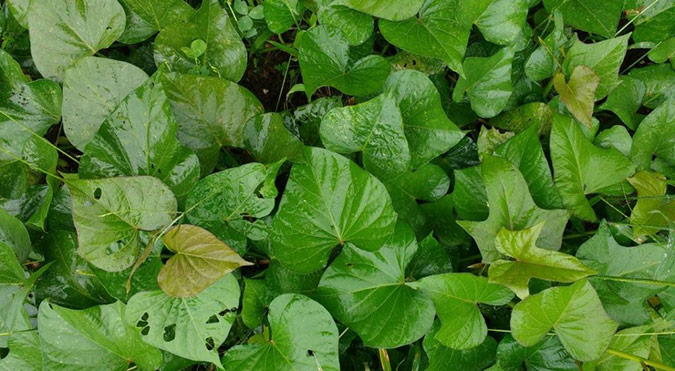

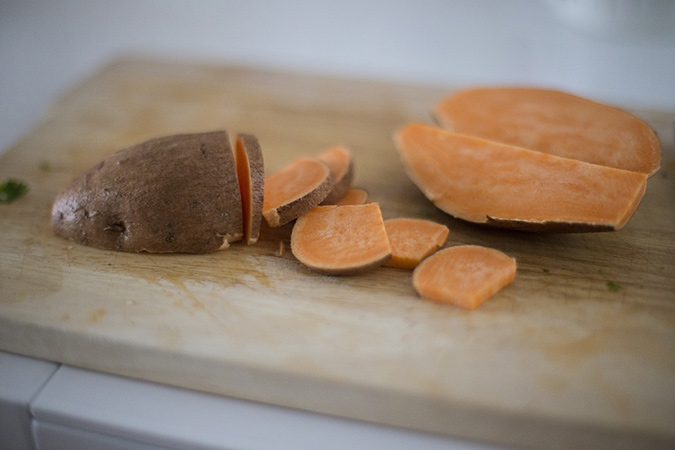







COMMENTS(13)
Wow. Why am I not growing sweet potatoes? They are perfect for my climate and soil.
And luckily, the greens can even grow well in rocky soils. Um, but the giant orange roots not so much. Take care where you plant them if you also want roots!
Are there any wild sweet potatoes growing like weeds that we can forage or any analogs that might make a good substitute?
I had no idea the greens were so useful. I imagine they would go well in place of broccoli or kale which I generally sauté with diced sweet potatoes and onions. Great info. Thank you so much.
Yes! Sweet potato greens with onions and sweet potatoes is awesome! Not sure if you are into the herbs, but when I do that, I also throw in a little minced hyssop or thyme to compliment the flavors. Bon Appetit!
I grow sweet potatoes here in north Alabama. They do pretty well. This year I’ll try to keep some for planting next year. I did not know how to do that and have never tried.
Hi Miss Patricia,
Thanks for reading. Starting your own sweet potatoes is simple and satisfying. If you can grow them, then I know you’ll have good success at making your own slips. Good luck in your gardening endeavors.
Tasha
In the article ‘Sweet Potato Vines: How to Grow This Antioxidant Powerhouse’ in the photo under the heading ‘Starting Sweet Potato Slips’ two places on the vines are circled in purple, but I could not find anything in the article below explaining the significance of this. Is this where you cut the vine to start a new vine?
This is my second year of growing sweet potatoes in containers. I used cuttings from what I harvested last year and now have five containers. The two or three of the plants have flowered several times.
Hey Texas1030 – Thanks for reading! The picture above with the two spots circled on one photo are the new roots starting to grow on the stem. You could cut just below those roots and use that section of the vine to start new plants for greens or roots.
For container growing, a lot of people use the bunch or bush type sweet potatoes. They have a more upright top growth and don’t set quite as many roots along the stem as the vining type. But, even with bunch or bush varieties, you can just lay one of your vines over in some moist soil, put a rock on it to hold it down, and it should root in a few days.
I would imagine container sweet potatoes would flower more than ground grown sweet potatoes because it’s harder to keep the soil consistently moist. Sounds like a good side-benefit of growing them in containers – you get a beautiful flower display too!
Best to you! Tasha
Tasha, Thank You!!
Been raising sweet potatoes for many years and have 7 varieties – different skin and flesh colors. This article made me laugh becuase my neighbor just started growing them last year and he always complains that his Korean girlfriend eats all the vines and he never gets any tubers.
Where I am at in NC, I am able to also glean some sweet potato fields for enough (usually a ton or two) to feed my goats, geese, chickens, horse, and pigs through the winter — keeps them fat and happy.
Hey Jake,
Wonder if we’re neighbors? I’m in Surry County NC. Sweet potato heaven as far as I can tell!
I just carried a load of vines to my goats yesterday. End of season, I have a deal with them. They get half of the vines for fresh eating and I get the rest to saute and freeze for winter. I harvest over a two week period so I can give them just the amount of greens they’ll eat each day until I am done.
That’s funny about your friend’s girlfriend! I’ve discovered in my travels that Americans tend to use far less of the plant parts than in many other cultures. And some parts of the US seem to use even less than others. Here in NC, for example people eat turnip greens, but when I lived in the DC area, turnips at the super market didn’t even come with greens (which is the best part!).
Thanks for reading. Good luck with your harvest this year!
Tasha
P.S. Do you happen to have a favorite variety you want to share?
I just joined this network and this is the first article I’ve read. If this is a good preview I’m going to love it!
I did this from a Stokes Purple Sweet Potato that sprouted. I waited until it had leaves growing, then buried it. It grew a huge vine that went everywhere. It was a fun and beautiful plant. But it didn’t grow one sweet potato. I figured it was because the plant was a hybrid. How do I get heirloom plants that I can grow over and over every year? Any variety is good. I like them all.